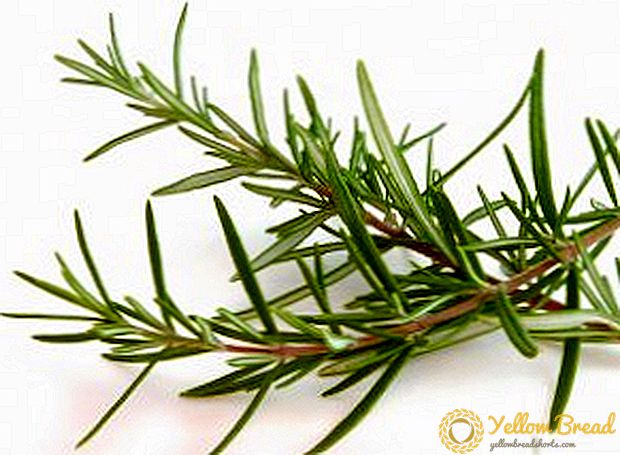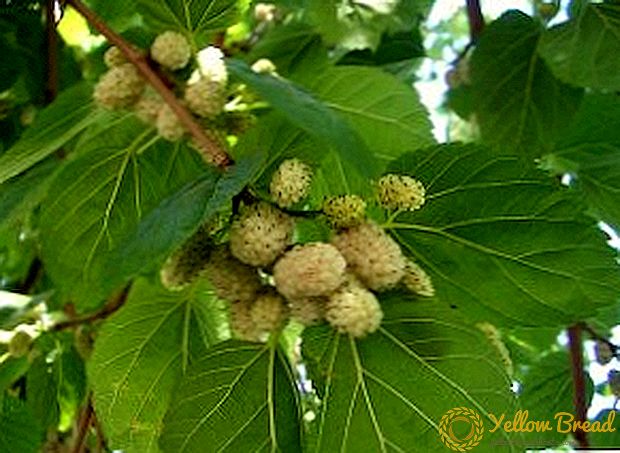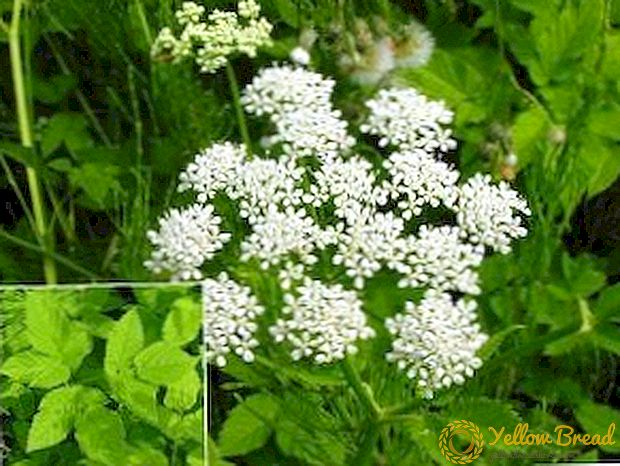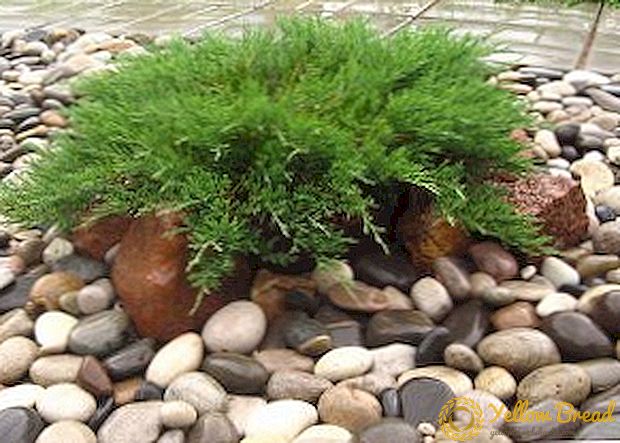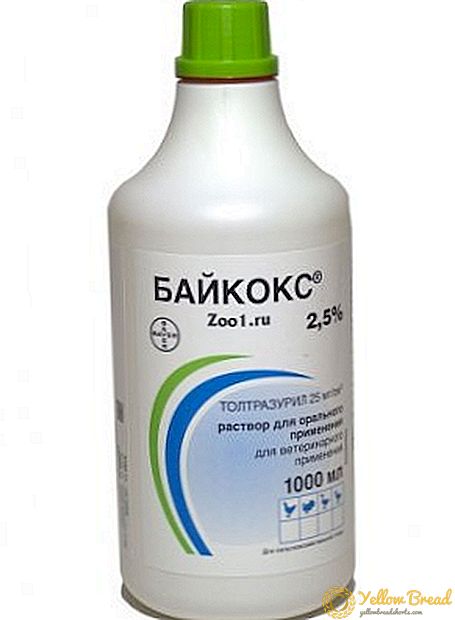 Before you plant strawberries garden, you need to familiarize yourself with all the pests that can eat the berry. This will help to carry out preventive measures efficiently and in time and will ensure maximum yield.
Before you plant strawberries garden, you need to familiarize yourself with all the pests that can eat the berry. This will help to carry out preventive measures efficiently and in time and will ensure maximum yield.
- Pliers
- Strawberry Mite
- Spider mite
- Strawberry leaf beetle
- Strawberry Nematode
- Strawberry raspberry weevil
- Cruciferous flea
- Dark Nutcracker (Wireworm)
- Aphid
- Bib penny
- Slugs
- May Western Hrusch
- Birds
Pliers
Consider the types of ticks that can be seen on the bed, the main features that determine the pest on strawberries, and methods of dealing with them.
Strawberry Mite
 One of the most dangerous pests for strawberries is the strawberry mite. It is impossible to see him with the naked eye, because it is up to 0.2 mm in length. In all phases of its development, strawberry mite lives on the young leaves of the plant, feeding on its juice. The mite is particularly bad for strawberries in the second half of summer. The tick causes damage not only to the harvest of the current year, but also to the future, since it disrupts the formation of flower buds at the end of summer.
One of the most dangerous pests for strawberries is the strawberry mite. It is impossible to see him with the naked eye, because it is up to 0.2 mm in length. In all phases of its development, strawberry mite lives on the young leaves of the plant, feeding on its juice. The mite is particularly bad for strawberries in the second half of summer. The tick causes damage not only to the harvest of the current year, but also to the future, since it disrupts the formation of flower buds at the end of summer.
On what grounds can you determinethat the plants were attacked by strawberry mite? First, the yield of strawberries is significantly reduced, the leaves shrivel, acquiring a yellowish-oily shade, and die. Secondly, plants overwinter badly and may die.
The fight must begin in early spring. First you need to remove all dry leaves from the bed and after disinfection put them in the compost. This will reduce the number of pests. Then you can conduct heat treatment. On each bush, you need to pour about 0.5 liters of hot water to 80 ° C. After this, the plants need to pile up and feed. Also effective against strawberry mites is treatment with 70% solution of colloidal sulfur. Processing should be carried out with an interval of 2 weeks: in the period of growth of leaves, before flowering, after the formation of berries.
 Before the appearance of the leaves of the plant, the earth can be treated with a 3% solution of Bordeaux liquid. This will help in the fight not only with the tick, but also with other pests and diseases.
Before the appearance of the leaves of the plant, the earth can be treated with a 3% solution of Bordeaux liquid. This will help in the fight not only with the tick, but also with other pests and diseases.
To folk remedies in the fight against strawberry mite are spraying infusion of onion peel or garlic decoction.It is better to treat the plant with pesticides after harvesting or in spring, with the appearance of the first leaves. To do this, you can use the "Fufanon", "Kemifos", "Aktellik" according to the instructions. Eat berries can only be a month after the chemical treatment.
Choose for the seedlings resistant to the pest varieties: "Omsk early", "Vityaz", "Zarya", "Zenga-Zengana", "Torpedo".
Spider mite
If the leaves of strawberries are shrouded in cobwebs and turned yellow, then this indicates the defeat of plants with spider mites. This usually occurs after harvest. For the fight using insecticides - drugs against ticks on strawberries: "Vermitek", "Fitoverm", "Actofit". The drugs are not able to kill the eggs of the tick. Therefore, it is necessary to spray the plants several times at intervals of two weeks.
 With a large defeat of the plant with a tick, it is necessary to mow and destroy the infected leaves. This procedure is carried out at the beginning of August. Next, the bed is well watered and fed to the plants had time to form the crown before the onset of cold weather.
With a large defeat of the plant with a tick, it is necessary to mow and destroy the infected leaves. This procedure is carried out at the beginning of August. Next, the bed is well watered and fed to the plants had time to form the crown before the onset of cold weather.
Strawberry leaf beetle
Strawberry leaf beetle is a small yellow-brown bug measuring 3-4 mm, which damages the leaves, which can lead to the death of the plant. Harm is brought by both larvae and beetles. Beetles gnaw holes in the center of the sheet and along the edges, eating away the pulp with winding passages. The larvae gnaw through the window from the underside of the leaf. Focal reproduction of this pest is noted.
 The methods of control are based on loosening the soil under the bushes at the end of strawberry fruiting and insecticide treatment in the spring.
The methods of control are based on loosening the soil under the bushes at the end of strawberry fruiting and insecticide treatment in the spring.
Strawberry Nematode
The nematode is a small worm with a length of 1 mm round, white or brownish in color. With forceps that are in the nematode's mouth, it attaches to the stems or roots of plants and injects a substance into them that makes the plant an easily digestible food product. Nematode females do not lay eggs, and, attached to the plant, form cysts. In one cysts up to 1000 eggs.
Survival in the cyst is very high. They are not afraid of any chemicals or other adverse conditions. For several years, cysts can wait in the ground for favorable conditions for procreation.
Recognizing the nematode at the initial stage is almost impossible. It gradually affects plants and soil, and this leads to a deterioration in the quality of the crop.
On what grounds can you recognize the nematode on strawberries? These are inhibited development of the roots and leaves of the plant, the presence of cysts on the roots, in the form of small white dots, slow growth of the plant, wrinkling of the foliage and thickening of its vein, a defective form of berries.
The fight against the nematode is a long process and involves an integrated approach.
 To effectively combat the nematode, it is necessary to begin it at the stage of planting seedlings. To do this, choose healthy seedlings and before planting treated with a solution of "Parationa" or "Fosdrina". The roots of the plant are immersed in a chemical solution of the required concentration for 10-15 minutes, a field of which is washed with running water.
To effectively combat the nematode, it is necessary to begin it at the stage of planting seedlings. To do this, choose healthy seedlings and before planting treated with a solution of "Parationa" or "Fosdrina". The roots of the plant are immersed in a chemical solution of the required concentration for 10-15 minutes, a field of which is washed with running water.
You can also effectively use heat treatment of plants.For this, the plants are immersed in hot water (approximately 50 ° C) for 10 minutes, and then in cold water, after which they are planted in the ground.
Nematode is afraid of fungus. Therefore, it is recommended to periodically fertilize the soil with compost, which contributes to the development of fungi that are safe for humans and dangerous for nematodes. There are plants that help fight the nematode. They must be planted next to the bushes of strawberries. These include marigolds, calendula, rudbeckia, etc.
Do not thicken the beds. Timely weeding and fertilizer will help reduce the amount of nematodes in the soil.
Such preparations from nematodes: Oksikor, Fundazol, Fitoverm, Skor, etc. are considered to be chemical agents for the control of affected strawberry plants. They must be used according to the instructions.
Strawberry raspberry weevil
 Strawberry-raspberry weevil is a dangerous pest. It can destroy up to 90% of the crop of strawberries. It is a black beetle, 2-3 cm long, with a long vertex with a mustache. First, beetles use spring leaves of strawberry for their food, gnawing holes in them, then, when buds appear, beetles eat the anthers of the plant.During the mating period, the female gnaws a strawberry bud and lays an egg. Bud dries out over time and falls to the ground.
Strawberry-raspberry weevil is a dangerous pest. It can destroy up to 90% of the crop of strawberries. It is a black beetle, 2-3 cm long, with a long vertex with a mustache. First, beetles use spring leaves of strawberry for their food, gnawing holes in them, then, when buds appear, beetles eat the anthers of the plant.During the mating period, the female gnaws a strawberry bud and lays an egg. Bud dries out over time and falls to the ground.
The larva weevil on strawberries can be seen in the second half of May. Then the larva turns into a pupa, and after 3 weeks into a beetle.
Harm is brought by both beetles and weevil larvae. But especially dangerous for early varieties of strawberries, destruction of buds during egg-laying. What are the signs of the appearance of weevil on the bed of strawberries? These are small punctures of foliage in early spring, damage and drying of buds and the presence of larvae in them.
Mechanical methods of dealing with the weevil include the collection of foliage and fallen buds and shaking off beetles on film, as well as autumn digging of soil under bushes. Spraying plants with decoctions of hot peppers, tansy, laundry soap and mustard, onions and celandine are among the popular methods of struggle. Scare weevil marigolds, marigolds, nasturtium and garlic.Therefore, they can become good neighbors bed of strawberries.
The chemical means of struggle include Fufanon-Nova, Kemifos, Iskra-M, Novoaktion. Spraying is carried out before and after flowering according to the instructions.
Cruciferous flea
 Cruciferous flea - tiny black bugs, got their name from the name of the cruciferous family, that is, those plants that they use as food. These include cabbage, radish, turnip, rutabaga, radish, horseradish, etc. Flea wakes up as soon as the temperature has reached 15 ° C and are actively starting to feed on young leaves. The struggle should begin immediately, because they need one or two days to completely riddle the plants.
Cruciferous flea - tiny black bugs, got their name from the name of the cruciferous family, that is, those plants that they use as food. These include cabbage, radish, turnip, rutabaga, radish, horseradish, etc. Flea wakes up as soon as the temperature has reached 15 ° C and are actively starting to feed on young leaves. The struggle should begin immediately, because they need one or two days to completely riddle the plants.
Fleas do not like a wet environment. Therefore, young bushes should be watered abundantly. Also effective are dry pollination of leaves and aisles with a mixture of wood ash and lime in a 1: 1 ratio, a mixture of ash and tobacco dust, or a mixture of ash and road dust.
We should not forget about the plants that scare away fleas of their smell. These include dill, potatoes, garlic, tomatoes, coriander, marigold, calendula, etc.
The most effective way is chemical. To do this, treat the plants with an insecticide solution. Spraying is best done in the evening when the flea is sitting on the leaves.
Dark Nutcracker (Wireworm)
 Dark clicker is a beetle 15-16 mm long, brown or black in color. When turning on its back, it makes a sound in the form of a click, which is why it got its name. The harm of strawberries and vegetable crops is brought not by beetles, but by their larvae - delays. They have a yellow-brown solid, resembling a wire. The main hotbed for delays are areas covered with grass. Delays are moisture-loving insects and do not tolerate drying out of the soil.
Dark clicker is a beetle 15-16 mm long, brown or black in color. When turning on its back, it makes a sound in the form of a click, which is why it got its name. The harm of strawberries and vegetable crops is brought not by beetles, but by their larvae - delays. They have a yellow-brown solid, resembling a wire. The main hotbed for delays are areas covered with grass. Delays are moisture-loving insects and do not tolerate drying out of the soil.
The beds of strawberries, on which the larvae of clickers are most often found, are usually heavily littered with weeds and are neglected. The larvae gnaw the roots of strawberries and greatly weaken the bushes.
Consider ways to deal with the wireworm. Wireworm does not like plants such as mustard, rape, oilseed radish, black beans, beans, soybeans, peas, and marigold juice is poisonous to it. It is recommended to sow these crops on the plot, and the wire will leave.He also does not like an alkaline and neutral environment, so it is recommended to bring ashes or onion peels into the soil.
If the soil is acidic, it is necessary to conduct liming. For strawberries suitable bait from potatoes. Sliced potatoes must be buried along the edges of the beds in several places. Wireworms will crawl on the bait and leave the strawberries alone. The bait every three days, check and destroy the larvae gathered there. Since the wireworm likes wheat grass, it is necessary to get rid of this weed in the garden beds. Of the chemicals used insecticides "Barguzin", "Pochin", "Provotoks" according to the instructions.
Aphid
 Everybody who has planted cultivated plants and cared for them is familiar with aphids. Small green or black pests that feed on plant sap have time to foul not only on strawberries, but also on all young shoots or buds of plants. Aphids on strawberries are usually concentrated on the back side of the leaf.
Everybody who has planted cultivated plants and cared for them is familiar with aphids. Small green or black pests that feed on plant sap have time to foul not only on strawberries, but also on all young shoots or buds of plants. Aphids on strawberries are usually concentrated on the back side of the leaf.
She clings to young leaves and covers them with sticky liquid - paddy. The affected leaves curl and dry, the buds do not open and the fruits do not develop. The fight against aphids should start immediately.If the berries of the plant have already appeared, then the protection of strawberries from pests must be carried out by folk remedies.
These include spraying with soapy water (2 cups of water, 2 tsp. Of liquid soap), infusion of tomato leaves (2 cups of finely chopped leaves to insist in 2 cups of water), infusion of garlic (5 crushed garlic cloves, 2 tsp. Of vegetable oil, 2 glasses of water, 1 tsp. liquid soap), flushing of insects with a stream of water. Do not forget about plants that repel aphids. These include onions, garlic, chamomile Dalmatian.
Of the biological methods of dealing with aphids can be distinguished ladybugs and gold-eyed. To resort to the help of chemical means it is necessary in extreme cases. To do this, use insecticides "Aktara", "Phytoferm", "Fufanon" according to the instructions.
Bib penny
 During the formation of peduncles on the leaves of strawberries appear balls of foam. Under the foam is a tiny creature with a thickened head and a thin tail, which is actively moving, sticks a thin proboscis into a leaf of strawberries and sucks the sap of the plant.This is the Afrophorida larva, and the foam serves as its protection against predatory insects.
During the formation of peduncles on the leaves of strawberries appear balls of foam. Under the foam is a tiny creature with a thickened head and a thin tail, which is actively moving, sticks a thin proboscis into a leaf of strawberries and sucks the sap of the plant.This is the Afrophorida larva, and the foam serves as its protection against predatory insects.
As a result of exposure to penicature, the leaves become wrinkled, and the ovaries are underdeveloped. It is easy to fight the pest: it is necessary to powder each ball of foam with ashes, and the larvae will die.
Slugs
Garden slug on strawberries not only spoils the presentation of the berries, but also leaves a trace of mucus on them. Since slugs are nocturnal, it is almost impossible to see them in the afternoon on the garden. The most dangerous thing is that slugs are intermediate hosts of parasitic worms that cause intestinal diseases in animals and people.
 You can fight pests with the help of ash. With the help of a sieve we apply it with a thin layer on strawberry bushes, and the slugs are not touched. Also around the perimeter of the garden bed sprinkled with sawdust or sprayed plants with brine. It is also effective against slugs.
You can fight pests with the help of ash. With the help of a sieve we apply it with a thin layer on strawberry bushes, and the slugs are not touched. Also around the perimeter of the garden bed sprinkled with sawdust or sprayed plants with brine. It is also effective against slugs.
May Western Hrusch
One of the most dangerous pests for strawberries is the Maybot larvae. These are thick white-yellow worms, curved by a crescent, sometimes found when digging the ground. At a younger age, they feed on humus, and after 2-3 years - the roots of plants. It should be noted that strawberries, strawberries belong to their favorite delicacies.It is necessary to combat them in a comprehensive manner.
In infected or newly developed areas, it is necessary to sow the plants that do not tolerate the brute larvae: lupine, marigold, buckwheat, rape, and then dig them up. Compost and dung heaps must be shoveled during frost, then the larvae will die.
 The beds planned for strawberries must be treated with ammonia water in April-May and kept steaming and clean from weeds until next season. The larvae will contact with the soil and die.
The beds planned for strawberries must be treated with ammonia water in April-May and kept steaming and clean from weeds until next season. The larvae will contact with the soil and die.
Chemicals are also widely used in the fight. They make a plant under the bush in the spring before the appearance of berries. Common insecticides used to fight the larvae of the May Khrushchev include "Aktara", "Force", "Antihrusch". Apply them according to the instructions.
Birds
Birds can significantly damage your strawberry harvest. To prevent this, it is necessary to divert their attention and resort to some tricks. If you arrange around the beds the red balls used in the design, they will attract the attention of birds, but they obviously will not like them to taste. It will distract them and will not cause interest in the ripening of strawberries.It will also be effective to stretch the net over strawberries or place scare items.
To get a good harvest of strawberries, it is necessary to carry out preventive measures and processing strawberries from pests in spring. Be sure to remove rotted mulch, loosen the soil, transplant to the place of dead bushes young and apply fertilizer.
Treatment of bushes from pests and diseases in the spring is carried out at least three times. This will significantly increase the chances of getting a big crop.

